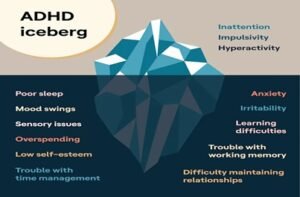
Distinguishing ADHD: Disorder, Symptoms, and Impairment
| Aspect | Definition | Examples |
| Disorder | Neuro-genetic origins | ADHD diagnosis requires meeting specific DSM-5 criteria (e.g., symptom count, duration, and impact). |
| Symptoms | Cognitive-behavioral expressions | – Inattention – Hyperactivity – Impulsivity – Deficient Executive Functioning |
| Impairment | The functional consequences of ADHD symptoms in the natural ecology – The Environment ´´Kicking Back´´ | – Poor academic performance due to inability to focus. – Difficulty maintaining relationships due to impulsive behaviors. – Workplace challenges like missed deadlines. |

The “bull curve” is a way to show how people with ADHD perform on tasks that require executive functions (EF), like attention, memory, planning, and impulse control, compared to people without ADHD. It helps us understand that people with ADHD can have a wide range of abilities when it comes to these tasks.

Key Points:
Executive Functions (EF): These are the mental skills needed to plan, focus, remember things, and control impulses. For example, working memory, flexibility, and self-control.
ADHD and EF: People with ADHD often struggle with EF tasks, such as focusing or organizing tasks, but their challenges can vary widely.
The Bull Curve:
The curve shows a typical pattern where most people without ADHD perform well on EF tasks.
For people with ADHD, there is a broader range of abilities. Some may struggle a lot, while others may do just fine or even excel in certain areas.
Treatment Implications: Since people with ADHD have different levels of EF abilities, treatment needs to be personalized. What works for one person might not work for another, and each person may need support in different areas.
ADHD Varies by Setting:
| Better here | Worse Here |
| Fun: Engaging and enjoyable activities help sustain focus and motivation for individuals with ADHD.
Immediate: Quick feedback or rewards help keep attention focused and prevent distractions. Frequent: Regular changes or variations in tasks can prevent boredom and maintain engagement. High: High-energy or stimulating environments enhance alertness and attention. Early: Morning or early parts of the day are often when individuals with ADHD are most focused and productive. Supervised: Close supervision provides structure and accountability, improving task completion and focus. One-to-one: Personalized, one-on-one interactions reduce distractions and allow for better focus. Novelty: New or unfamiliar tasks create curiosity and can boost engagement and concentration. Fathers: Some individuals with ADHD may respond better to the parenting style of fathers, which can provide additional structure or stimulation. Strangers: Interactions with unfamiliar people or in new environments may serve as stimulating challenges, helping to improve focus. Clinic Exam Room: A structured, quiet setting like a clinic exam room can promote focus and reduce distractions. |
Boring: Monotonous or repetitive tasks lead to boredom and difficulty maintaining focus.
Delayed Consequences: Tasks with rewards or outcomes that are delayed make it harder to stay engaged and motivated. Infrequent Feedback: Lack of regular feedback or recognition can lead to disengagement and reduced focus. Low Salience: Tasks that feel irrelevant or have little personal importance are harder to focus on. Late in the Day: Fatigue toward the end of the day can reduce attention and make it harder to stay focused. Unsupervised: Without supervision or structure, individuals with ADHD may struggle to stay on task and may become distracted. Group Situation: Group environments can be distracting and make it harder for individuals to focus due to competing stimuli. Familiarity: Familiar tasks or environments may be too routine, leading to a lack of interest and reduced concentration. Mothers: Some individuals may be less responsive to the familiar structure provided by mothers, possibly due to comfort or lack of challenge. Parents: Similar to mothers, interactions with parents can sometimes reduce motivation or focus due to the familiarity of the relationship. Waiting Room: A passive, unstructured setting like a waiting room can lead to restlessness and a loss of focus due to boredom and inactivity. |
Prevalence of ADHD:
Expect of Life Expectancy:
Comorbid Disorders in ADHD:
Etiologies; ADHD is a neurodevelopmental disorder primarily driven by genetic and neurological factors.

Here’s an overview of the key causes of ADHD:
Genetic Factors:
ADHD is highly heritable. Research shows a strong genetic basis, with the following key findings:
Neurological Factors:
ADHD is also linked to specific brain regions and networks:
Environmental Factors:
Although ADHD is largely genetic and neurological, certain environmental factors may increase the risk:
Misconceptions:
In summary, ADHD is primarily a genetic and neurological disorder, with environmental factors potentially playing a role in exacerbating or triggering the condition. Understanding these causes helps guide both the diagnosis and treatment of ADHD, focusing on neurological and genetic factors rather than behavioral or environmental explanations.
Conclusion on ADHD Management in Educational Settings: Effective ADHD management in educational settings hinges on mental health professionals having a comprehensive understanding of:
Armed with this foundational knowledge, professionals can craft tailored intervention plans, selecting from over 80 behavior management strategies and classroom accommodations. These interventions are guided by: 10 Core Principles: Grounded in the understanding of EF deficits inherent in ADHD, these principles form the basis for effective support.
By integrating these elements, educators and professionals can create supportive environments that empower children and teens with ADHD to succeed academically and socially.
Leave a Comment